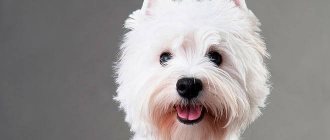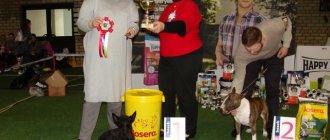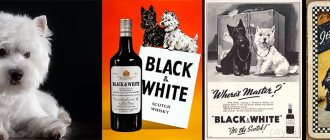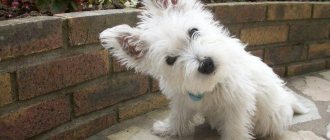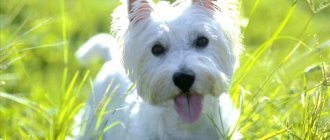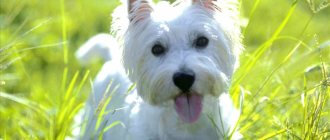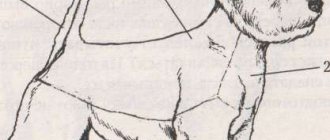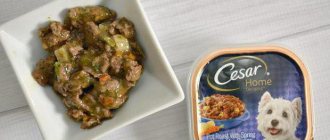History of the West Highland White Terrier breed
West Highland White Terrier
The West Highland White Terrier is a fairly ancient breed, so there is not as much reliable information about its origin and development as we would like. The few written sources from the Middle Ages claim that the ancestors of today's West Highlands successfully hunted small animals back in the 12th century. At the same time, modern researchers are sure: the true history of this variety of terriers began at least several centuries earlier.
The homeland of the West Highland White Terrier is considered to be western Scotland with its rocky ridges and minimalist mountain landscapes (West Highland from English - western highlands). It was here that the small but tenacious shaggy creatures revealed their hunting potential, pulling otters out of rock crevices and digging up badger holes. What is interesting: at first, West Highland White Terriers had a wider palette of colors, ranging from fawn to brindle varieties. But in those ancient times, individuals with white fur were not valued, as they were considered too sickly, so owners tried to get rid of all white puppies in the litter.
The breed owes its current appearance to two eminent Scots who lived at the turn of the 19th and 20th centuries - Colonel Edward Malcolm and the 8th Duke of Argyll, George Campbell. Both gentlemen approached the issue of breeding animals innovatively, starting to select and in every possible way promote white-haired Westies. Well, since in those days the name West Highland White Terrier had not yet been assigned to the breed, the colonel’s charges were dubbed Poltalloch Terriers (after the name of the estate in which they were bred), and the Duke of Argyll’s pets were called Rosenet Terriers.
The first club for fans of the West Highland White Terrier breed opened in Scotland in 1904, and its founder was a descendant of that same George Campbell. Quite soon, or more precisely, three years later, the first nursery, specializing in breeding snow-white Westies, began its activities. However, it was possible to put an end to the formation of the unique exterior of the breed only in 1924, after breeders were officially prohibited from exhibiting at exhibitions dogs whose pedigree included other representatives of the terrier group (Scottish terrier, Cairn terrier).
The nursery is officially registered with the RKF and FCI under No. 411
December 02, 2022 we turn 23 years old
We have new mail address
N O R V I C H I
SMALL HOTEL FOR SMALL BREEDS OF DOG tel.: 8(916)727-1649 Ekaterina
Small films that may be of interest to both beginners and experienced owners...... (click on photo)
Norwich terrier RAGUS CLASSIC ROCK (Rocky), 14 x CACIB, International Champion, Junior Champion of Russia, Champion of Russia, Belarus, Champion of Finland, Spain, Portugal, Gibraltar, Eurasian Champion 2014,
BRAIT NOUZ CEPPELIN moved to new owners in the Chelyabinsk region, owners - Olga Rostovtsev and Paveltel. and +7 950 745 44 50 https://belyhroz.jimdo.com/
ANOTHER NEW MANUFACTURER (rental)
Ch.Finland and now also Russian Champion BE MY STAR SUPERBIA
NEW PRODUCER (end of lease April 26, 2012) VOO DOO PAI VERTRAGUSJUNIOR EUROPA WINNER — 2011 Best Junior Eurasia — 2011 Junior Russian Champion, Russian Champion Junior Champion of National westie Club of Russia father: Multichampion HAVASU PAI mother: Ch. LEONHARD'S MIRACLE
BRAIT NOUZ ON THE RIGHT WAY (hedgehog) became the Young Winner and Junior Champion of the National Club 06/12/2011 - received the last certificate and became the CHAMPION of the NATIONAL CLUB and GRAND CHAMPION OF RUSSIA, Junior Champion and Champion of Russia
CONGRATULATIONS!!! BRAIT NOUZ OSGUD FEELDING (Bobik) - became the Champion of the National Club and completed the title of INTERNATIONAL Champion
BRAIT NOUZ SHEIK ME UP (Lapa) won the strongest junior class at the National Club Championship on May 28, 2011 and became the YOUNG NKP CHAMPION
ANOTHER FINLAND CHAMPION BRAIT NOUZ EL PRINCE FOR WHITE VILLAN
New INTERCHAMPION!!!!! CONGRATULATIONS!!!MINE DREAMS DEGREE BY PERFECTION (owner Semenova)!!!
RESULTS OF THE 2009 WORLD CHAMPIONSHIP BRATISLAVA
Two dogs from our kennel were presented at the INTERRA-2009 exhibitions and at the World Championships.
BRAIT NOUZ DVD (Interra) – 2 ex. in the Champion class (of 6 dogs) BRAIT NOUZ TATOSHA (Inerra) - 3 exc. in open class (out of 10 dogs)
BRAIT NOUZ DVD (Ch.Mira) - 2 ex. in the Champion class (out of 14 dogs) -
click to enlarge
BRAIT NOUZ TATOSHA (Ch.Mira) – 4 exc. in open class (out of 22 dogs) -
click to enlarge
New Champion! WINDACRE WORD PERFECT added the title of Finnish Champion to the titles of Champion of Canada and Russia
New Champions! BRIGHT KNOSE ORKNEY - Champion of Russia BRIGHT KNOSE CHEEKEY AND CHANCEY - Junior. Champion of Russia BRIGHT KNOWSE ORINOKO - Champion Terrier of the Union Our victories! May 10, 2009 Regional Specialty Show BRIGHT NOUZ OSGOOD FIELDING - CCC, BOB June 14, 2009 Smolensk, international VOICE OF MIND FOR BRAIT NOUZ IRSIMOS - CACIB, BOB MAIN DREAMS DEGREE BY PERFECTION - CACIB BRAIT NOUZ WINDY FLOWER - R.CA CIB On May 23, 2009, the National Championship of our breed was held, it was a very successful day for the dogs of our kennel! Congratulations to the owners: REICHTMAN, PANINYKH, TOLSTIKOVA and ALESHINA, SEMENOVA!!! See the results of our dogs in the “SHOWS” section
On April 18, 2009, BRAIT NOUZ ZEPPELIN received the title of Junior Champion Terrier of the Union
According to the results of the BRAIT rating, NOUZ TATOSHA was recognized as the Best Junior of 2008
PUPPYS FOR SALE
Appearance of the West Highland White Terrier
West Highland White Terrier puppy
The West Highland White Terrier is a snow-white, compact shaggy dog with an inquisitive look, vaguely reminiscent of a Bichon Frize. Thanks to their sweet appearance and more than modest dimensions (the height of an adult dog is up to 28 cm, weight is up to 10 kg), West Highlands are quite suitable for the role of apartment dwellers. At the same time, they are not particularly fragile, like most representatives of decorative breeds, which means the owner does not have to control every step and jump of the pet.
Head
The skull of the West Highland White Terrier is wide, slightly convex, with a pronounced stop and prominent brow ridges.
Jaws and bite
Despite the fact that the West Highland White Terrier is an almost miniature dog, its jaws are powerful. As for the bite, representatives of this breed have a full, scissor-type bite.
Eyes
The wide and fairly deep-set eyes of the West Highland White Terrier have an almond shape and a dark iris color. The dog's gaze is intelligent and insightful.
Nose
The Westie has a large, black nose, which almost does not protrude beyond the muzzle.
Ears
The West Highland White Terrier's small, pointed ears are not set too wide and are carried straight. The outer side of the ear is covered with velvety fur, which is never cut.
Neck
Dogs have a moderately long and well-muscled neck, which gradually thickens towards the body.
Muzzle to lead
Frame
Great guy
The body of representatives of this breed is compact, with a straight back, strong lumbar region and wide croup.
Limbs
The front legs of the West Highland White Terrier are short, well muscled and without curvature or turning outward. In some cases, the animal's paws may be slightly turned out. Experts explain this feature by the fact that during the hunt, the ancestors of today's dogs tore up the ground, throwing it to the sides, which caused the slight spread of the limbs. The hind legs of the West Highland are short but sinewy, with a fleshy and broad upper part. Dogs' paws are round, with plump pads and tightly knit toes, with the front paws being noticeably larger than the hind paws.
Tail
The Westie has a straight tail up to 15 cm long, which it carries almost vertically.
Watching the rain
Wool
The West Highland White Terrier's coat consists of a dense furry undercoat and coarse outer coat, the length of which can reach 5 cm.
Color
The West Highland White Terrier is one of those few breeds, modern representatives of which exist in one single color - white. An important point: the color of the wool is extremely unstable and very dependent on external factors, so among animals there are often individuals whose “fur coats” have a yellowish tint.
Defects and disqualifying defects
Any more or less noticeable deviations from the standard can affect the exhibition assessment of show-class West Highland White Terriers. These are usually wavy or curly fur, large ears, a short or, conversely, excessively long neck, and atypical position of the limbs. As a rule, a dog may not be allowed to participate in competitions for two reasons: for displaying causeless aggression or cowardice, as well as for obvious defects in behavior and physical development.
West Highland White Terrier Appearance Standard
The West Highland White Terrier is a small dog with a harmonious build. The height of males is on average 28-30 cm, females - up to 26 cm. The weight of dogs does not exceed 10 kg, smaller females weigh 6-7 kg. In appearance, they are a little similar to the Bichon Frize, but are sturdier, stronger and more active.
Head
The head is large, the skull is wide, with prominent brow ridges. The muzzle is of medium length, tapering slightly towards the nose. The bridge of the nose is straight, the stop is sharp, well defined, the lobe is large and black. The jaws are powerful and have a scissor bite. The lips are tightly compressed, dry, black.
The eyes are almond-shaped, set wide and deep. The color of the iris is almost black, the whites are not visible. The look is smart, attentive. The ears are small and erect. They have a triangular shape with sharp tips. Planted close together on the crown of the head.
Frame
The neck is of medium length, muscular, gradually widening towards the body. The body is compact, almost square in shape. The chest is deep, the lower part of the body is level. The back is straight, short, the croup is wide. The tail is straight, of medium length (12-15 cm), held almost vertically. Should not lie on your back or twist.
Limbs
The limbs are straight, short, and muscular. The front ones may be slightly everted, which is due to these dogs' past as burrowers. The thighs are wide, sinewy, and the joints are well defined. The paws are rounded, the toes are clenched. When moving, the dog places its limbs parallel and pushes off powerfully from the ground. She is resilient, runs fast, and can jump high.
Coat and color
The West Highland White Terrier has a medium-length, double coat. The guard hair is straight, hard, shiny and requires regular trimming. The length on the body reaches 5 cm, the longest it is on the stomach. The hair on the head, ears, front surface of the limbs, and tail is shorter. There is a soft, thick undercoat, like fur, that fits tightly to the body. This coat protects the skin from branches, thorns and bad weather.
The color standard for representatives of this breed is only white. There should be no stains. It should be taken into account that the color depends on nutrition and care characteristics. Sometimes the fur may acquire a yellowish tint, and on the mustache and under the eyes it may turn brown.
Photos complement the description of the appearance of West Highland:
Photos of West Highland White Terriers
Character of the West Highland White Terrier
West Highland White Terriers are white and fluffy on the outside only. Inside, these charming “Scots” are far from being such good boys as they seem at first glance; moreover, they are quite stubborn and do not really like to obey the chain of command. At the same time, compared to their more aggressive and temperamental relatives in the terrier group, West Highland White Terriers seem, if not quite quiet, then quite manageable pets. However, this is not an innate advantage, but rather the result of the work of breeding specialists, who for a long time “extinguished” the hunting instincts of the breed and stimulated its companion qualities.
Lead with your owner
All West Highland White Terriers do not like to be ignored, and these snow-white babies do not cope well with loneliness. So before you bring a young messenger into your home, think about whether you are ready to sacrifice silence and your own peace for the sake of a four-legged nimble. West Highland White Terriers have a partnership-like relationship with children: they enjoy playing together, while both parties taking part in the process feel equal. It’s another matter if the dog has to deal with kids who, due to their thoughtlessness, can annoy it with intrusiveness or cause pain. In this case, the news will definitely fight back (guess in what way).
The West Highland White Terrier can easily delegate guard duties. Most representatives of this breed have acute hearing and are able to warn the owner about the appearance of a stranger with a ringing bark. At the same time, they do not experience any particular hostility towards strangers, which means they will not frighten your guests with sudden attacks and dissatisfied grumbling.
Despite all the efforts of breeders, the specialists in burrow hunting in West Highland White Terriers have not completely died out, so from time to time the dogs will be drawn to feats. In particular, on walks, Westies will selflessly dig trenches in search of an imaginary gopher, and when they see a garbage rat or some other small animal, they will immediately rush into battle. Treat this pet behavior with slight irony: after all, every breed has its own harmless cockroaches.
West Highland White Terrier and cat
A few words about the breed
West Highland White Terriers are incredibly jealous of their owner and all the property that belongs to them - favorite toys, bedding, food and bowls. However, this does not prevent you from buying a West Highland White Terrier puppy in Moscow to have a faithful friend. These dogs are incredibly beautiful, and their appearance evokes affection among others. But if you see that the dog's tail is hanging down and its ears are laid back, most likely the pet is in a bad mood and may react unexpectedly to your provocations.
Regular grooming is a must if you want your dog to be beautiful. The West Highland White Terrier gets along well with other animals and can become your reliable and loyal friend.
Breed standard
West Highland White Terriers have strong bone structure for such a small breed. Their heads are round in shape and their limbs are incredibly muscular. The West Highland White Terrier is a white dog that weighs a little - from 6 to 8 kilograms. The average height of a dog is 25-30 centimeters. A characteristic feature: the teeth of dogs of this breed appear large compared to the rest of their body, which is explained by a special scissor bite.
West Highland White Terriers have beautiful, bright, but deep-set eyes with a penetrating gaze. The ears are small, but always remain upright. These are dogs with soft, medium-length fur, but a fairly dense undercoat. Before you buy an inexpensive West Highland White Terrier puppy, keep in mind that these dogs have webbed feet.
Education and training
High five!
A West Highland White Terrier will never follow the commands of someone it doesn’t respect and considers obviously stupider than itself, so the first thing you should start training a dog with is asserting your own authority. In addition, the pet will have to be constantly stimulated, since this is not a breed that will work on sheer enthusiasm. If your charge has successfully completed the command, appease him with a tasty treat, and then give him a play break - West Highland White Terriers love to rage aimlessly and fool around no less than they love to hunt. By the way, about games: from the very first days, let your pet understand that practicing hunting skills on the owner and other family members is strictly prohibited. If your angry West Highland White Terrier still tries to taste your hand or foot, gently redirect his attention to the toy.
Important: while training and practicing commands, try to remain alone with your pet. The presence of strangers only slows down the training process, since it is more difficult for a dog to concentrate if two people are communicating with it at the same time.
You should accustom your West Highland White Terrier puppy to a collar and leash before going on its first walk. To do this, buy a one and a half to two meter strap and an unfastening collar with a lock, which will not need to be put over the head, thereby frightening the animal. Once your Westie is 10 months old, you can train with him on the playground. It is better to enroll difficult-to-train and particularly stubborn individuals in some kennel club, where an individual training program will be selected for them, and their behavior will also be adjusted.
If you don’t want your time together with your West Highland White Terrier to turn into a “who will win” confrontation, pay special attention to teaching your pet basic norms of behavior. In particular, do not let the Westie lie on your bed and do not let him look with hungry eyes at the family members gathered at the table. And there are no exceptions to the rules or concessions: despite the external weakness and fragility, the West Highlands are simply masterful at twisting the rope out of the owner.
West Highland White Terrier in a basket
Westie goes through an obstacle course
Hunting with a West Highland White Terrier
As noted earlier, it is not customary to go after foxes and badgers with today's West Highland White Terriers. Moreover, at competitions and exhibitions, representatives of this breed have long been evaluated exclusively by external parameters and almost never by working qualities. On the other hand, no one has the right to prohibit the owner of a West Highland White Terrier from going with his ward to hunt the animal. So if you are eager to try out your pet in action, sign up for any kennel club that has a training hole, and practice your pupil’s hunting talents as much as you want. As practice shows, people are extremely reckless in their work, but at the same time they do not lose their minds. In addition, they very quickly learn the habits of a wild animal and can change tactics at lightning speed if the situation requires it.
Maintenance and care
Every year, West Highland White Terriers are increasingly turning into indoor/sofa pets, and the reason for this is the desire of the owners to keep the soiled “fur coats” of their charges relatively clean. However, by nature, Westies are not such sissies and are quite capable of spending time outside, even if the weather leaves much to be desired. Bright, cute clothes and blankets, which West Highland White Terriers are often dressed in, are by no means a forced measure, but rather the owner’s desire to emphasize the uniqueness of his pet. In reality, West Highland White Terriers do not suffer much from the cold even in the winter months, provided, of course, that you do not keep the dog outside all day.
Combing wool
Grooming a West Highland White Terrier
Nail cutting
Trimming and cleaning the coat of the West Highland White Terrier
Well groomed West Highland dog at a dog show
A pleasant bonus for fans of sterile cleanliness: West Highland White Terriers do not shed and have virtually no odor. Of course, the coat of animals is regularly renewed, but dead hairs from their “coats” do not fall out, but simply fall off. Accordingly, in order to maintain the pet’s image, it will have to be trimmed once every couple of months or, if it is a show dog, every 30 days. Grooming is prohibited for these charming shaggy dogs, as it changes the structure of the coat, softening it and causing the hair to curl into a curl. As a result, the West Highland White Terrier loses its original appearance and becomes like a hybrid of a lapdog and a Bichon Frize. However, if you are not ambitious and do not plan to go to exhibitions, you can try to cut your ward’s hair. Your self-esteem will not suffer from this at all.
Before trimming, the West Highland White Terrier is thoroughly combed, after which the throat area and the area at the elbows are treated as briefly as possible with a stripping knife. The line from the withers to the croup, as well as the ridge of the neck, is also pinched with a knife, maintaining a total length of fur of 4-5 cm and smoothing out the transitions. As an example: an exemplary West Highland White Terrier should have short hair on the sides and a so-called skirt - lush, adorning hair on the chest. The hair on the forehead, crown and cheekbones is plucked by hand (placking technique), giving the head the shape of a chrysanthemum. The hair on the legs is usually not shortened.
If you want to preserve the unique snow-white color of the West Highland White Terrier, be prepared to spend an extra hour and a half on your pet’s “fur coat.” The fact is that the fur of representatives of this breed often turns yellow when dog saliva or food gets on it, so to neutralize the unwanted undertone it is necessary to use a cleaning composition of crushed chalk and boric acid. The mixture is rubbed into slightly moistened wool, after which its chalky particles are combed out with a regular hair brush.
Hygiene
Once a month, West Highland White Terriers are bathed using diluted pet shampoo (conventional products are not suitable). Not the most useless purchase is a whitening shampoo, which allows you to preserve the exquisite shade of the Westie's coat. Just don’t test it on a puppy, otherwise you risk seriously damaging the baby’s hair structure. Otherwise, representatives of this breed are suitable for any detergent compositions designed specifically for wire-haired dogs.
Hello!
Once every 5-6 days, the West Highland White Terrier should be combed with a sparse comb with metal teeth, which will not tear the undercoat, but will only gently remove dead hair and debris. But this is only if the pet’s coat is tough and healthy. Individuals with soft fur will have to be combed more often, otherwise you will get tangles. In addition, do not forget to wipe your dog’s face with a napkin after eating so that food debris does not get stuck in the fur and cause a change in its color.
Once a week, you need to pay attention to your ears: pluck out long hair that interferes with the free circulation of air inside the ear funnel, and remove dirt accumulated in the ear shell. It is best to examine the West Highland White Terrier's eyes every day. If brown streaks are found on the fur under the lower eyelids, the dog most likely has an allergy, so grab your pet and run to a veterinarian for a consultation. Westies have their teeth brushed a couple of times a week. In addition, it is useful to introduce various solid foods into the dog’s diet, particles of which act as abrasives and partially remove plaque. The paws of the West Highland White Terrier also need care, so after each walk they should be washed thoroughly, and in winter, when the roads are sprinkled with reagents, they should also be lubricated with vegetable oil.
Walk
If your West Highland White Terrier does not hunt (and he most likely does not hunt), he will have to compensate for the lack of adrenaline and positive emotions with walks and training. Westies must be taken outside at least twice, or preferably three times a day, and this should not be a 15-minute run around the playground. The first walks begin at 3 months of age, after the puppy has undergone routine vaccination and spent a week in quarantine. By the way, up to 6 months, babies are taken outside (they are taken out, not taken out) 5-6 times a day, which is due to the need to develop in them the ability to relieve themselves outside the home.
Westies love to rummage in the ground and are capable of destroying a well-groomed flowerbed or green lawn in a matter of minutes, so if you don’t want to constantly argue with landscape designers and utility workers, it’s better not to let your pet off the leash within the city. When walking with a West Highland White Terrier in nature, it is also better not to lose vigilance. Firstly, because dogs intoxicated by unfamiliar smells and sounds instantly become difficult to control. And secondly, because the Westies have a real passion for carrion, in which they prefer to wallow thoroughly before responding to the owner’s command.
West Highland White Terrier on a walk
Feeding
Who do you take me for?
The diet of the West Highland is not much different from the menu of its other terrier brothers. In particular, half of the dog’s meal should consist of lean meat, which is supplemented with vegetables (broccoli, pumpkin, turnips), cereal porridge (rice, buckwheat), fermented milk products and fruits. However, since most dogs are prone to food allergies, menu planning should be approached with the utmost caution and preferably with the involvement of a veterinarian.
Once and for all, eliminate chicken and wheat from your West Highland White Terrier's diet. The same rule applies to industrial feed. If you find wheat flour and “chicken” in the store-bought “drying”, return this product to the shelf and never look at it again. As for vitamin supplements, you can periodically add crushed greens (nettle, dandelion, parsley), brewer's yeast and salmon oil to the food of West Highland White Terriers. Once a week it will be useful to treat your fluffy with a quail egg, and during the season you can pamper him with half an apricot, a piece of pear or a ripe plum. By the way, despite the fact that sweets are strictly prohibited for West Highland White Terriers, dogs are simply crazy about them. So when you're ready to enjoy some ice cream or candy, don't forget to hide well from the four-legged beggar.
Please note: the West Highland White Terrier's coat may change color and acquire a yellowish tint if the dog's diet includes foods containing artificial or natural dyes. For pets this is not critical, but for show-class animals such changes can seriously spoil their exhibition career.
Westie enjoying the sunset
Features of maintenance and care
West Highland White Terriers are indoor dogs. They live quietly in a house or city apartment. Although they are unpretentious and tolerate any weather conditions well. But many owners put clothes on their pets when going outside to keep their fur snow-white.
Due to its small size, the white terrier can be trained to go to the toilet at home using a diaper or litter tray. But it is necessary to take them outside. Adult dogs need to be walked 2-3 times a day for 40-60 minutes. Walks should be active, with outdoor games. Representatives of the breed are ready to run all day, but physical activity should be limited, especially in puppies - this can lead to problems with the joints.
It is recommended to visit parks, dog parks, and take your dog out into nature. But in the city it is better not to let your pet off the leash. A Vestik can dig up a flowerbed or lawn, chase a rat, or wallow in carrion. Interested in an unfamiliar smell, he may run away. Therefore, the dog needs to be loaded with physical and intellectual exercises. Representatives of the breed love to fetch a ball or stick and look for hidden objects.
At home, you need to give your pet a comfortable place away from drafts and heating appliances. There should be soft bedding and a lot of toys so that the dog can entertain himself when he is left alone. Like all terriers, representatives of this breed love to steal small things and hide them in their place.
Grooming
Representatives of this breed are unpretentious and caring for them is not difficult. But to maintain the beauty of its snow-white coat, regular grooming will be required.
Like all wire-haired dogs, the Westie's coat does not shed. The hair falls out, but remains in the coat and falls off. Therefore, these dogs are trimmed regularly. Haircutting is not recommended. After this, the hair becomes soft, begins to curl and fall into tangles. The groomed dog of this breed looks like a lapdog. But some owners who do not show their pets give it haircuts in the summer to make it easier to care for its coat.
You can trim your West Highland White Terrier yourself or go to a grooming salon. It is recommended to do this for an adult dog 3-4 times a year. The first time the procedure is performed is 3-4 months. This will help form the correct silhouette and achieve the multi-layered coat that representatives of the breed should have.
Before the procedure, the hair must be combed well. Using a stripping knife, shorten the hair at the elbows and on the throat. On the back and neck, you need to achieve an even coat 4-5 cm long. On the head and ears, the hair is trimmed by hand. You don't have to touch the limbs. A properly trimmed dog looks attractive: the hair is short on the sides, longer on the chest, and there is a neat mustache and beard on the face.
To care for the West Highland White Terrier, you will also need grooming - regular hygiene procedures.
- You need to bathe your dog once every 1-3 months. These dogs are clean, their coat does not emit a specific odor. You need to use a special shampoo for white wool. It is advisable that it be designed for wire-haired dogs.
- To maintain the whiteness of the wool, places where it turns yellow must be periodically bleached. A mixture of crushed chalk and boric acid is suitable for this. Moisten the wool, rub in the mixture, and then comb out the remaining chalk.
- The dog should be combed 1-2 times a week with a wide-toothed metal comb. Dogs that have their hair cut are brushed more often, as their hair quickly becomes tangled.
- It is recommended to wash your paws after every walk. In rainy weather, it is better to use waterproof clothing so that the dog does not get his belly dirty. In winter, roads are sprinkled with reagents that can corrode the pads, so they must be regularly inspected and lubricated with oil.
- After eating, it is recommended to wipe the face to remove any remaining food. This will help prevent yellowing of the coat and the appearance of an unpleasant odor.
- The hair on the face, paws and under the tail can be trimmed. This will make it easier to keep clean. If the dog is not being shown, it can have decorative haircuts.
- You need to clean your ears once a week. Be sure to pluck the hairs inside the ear, as they impede ventilation and can cause inflammation.
- Wipe your eyes daily. If red streaks appear under them, the dog may have an allergy. It's better to consult a veterinarian.
- You need to brush your pet's teeth a couple of times a week. To prevent tartar, you can give chewing bones and special treats.
- If your pet doesn't walk on the pavement a lot, its claws won't wear down. In this case, it is recommended to shorten them once a month with a nail clipper.
- In the warm season, be sure to treat the coat against external parasites.
Nutrition
You can feed your West Highland White Terrier either dry food or natural food. Usually the feeding method is chosen by the nursery, and then it is not recommended to change it immediately. The transition to another diet should be gradual. An adult dog is fed 2 times a day in small portions. It should not be overfed to prevent weight gain.
It is recommended to choose dry food, this makes it easier to determine the required amount. It should be premium or super premium, designed for active small breed dogs. For dogs with allergies, holistic treatments are more suitable. Premium dry food may contain dyes and additives that change the color of the coat.
When feeding naturally, at least half of the dog’s diet should consist of lean meat. It is mixed with rice or buckwheat porridge and vegetables. It is useful to give your pet fruits and dairy products. You can add fish oil, herbs, and brewer's yeast to your food. Vitamin supplements are given only on the recommendation of a veterinarian. It is advisable not to feed carrots, beets and other foods that can color the coat.
Many Westies are prone to food allergies, so menu planning needs to be done with caution. It is recommended to avoid chicken, wheat and other allergens. You should not give smoked meats, sweets, baked goods, fatty, spicy and salty foods.
Health
West Highland White Terriers live on average 12-14 years. With proper care, a dog can live up to 16 or even 18 years. Representatives of this breed rarely have hereditary pathologies. But there is a tendency to such diseases:
- allergic reactions;
- dermatitis;
- ichthyosis;
- cataract;
- joint dysplasia;
- diabetes;
- meningoencephalitis;
- Perthes disease;
- blood clotting disorder;
- cardiovascular diseases.
Health and Diseases of West Highland White Terriers
West Highland White Terriers live an average of 13-15 years and are less prone to hereditary diseases than their terrier counterparts.
Diseases that may occur in West Highland White Terriers:
- cranial osteopathy;
- atopic dermatitis;
- epidermal dysplasia;
- ichthyosis;
- congenital deafness;
- hip dysplasia;
- diabetes;
- von Willebrand disease;
- cardiovascular diseases;
- meningoencephalitis of white dogs;
- Perthes disease;
- Shaker syndrome;
- hyperuricosuria.
Breed traits
Breed traits (on a 5-point scale)
| West Highland White Terrier | |||
| Activity | in the house | 3.4 | |
| on the street | 3.9 | ||
| Obedience | training | 3.4 | |
| strangers | 3.4 | ||
| Domination | in family | 2.4 | |
| over dogs | 3.2 | ||
| Defending your territory | from people | 2.2 | |
| from dogs | 3.3 | ||
| Sociability | in family | 4.8 | |
| with strangers | 3.8 | ||
| with dogs | 3.5 | ||
| Concentration | in family | 1.4 | |
| in front of strangers | 2.1 | ||
| with dogs | 2.1 | ||
| Aggressiveness | in family | 1.5 | |
| to strangers | 2 | ||
| to the dogs | 2.6 | ||
| to cats | 3.2 | ||
| Family behavior | calmness | 4 | |
| demand for affection | 4.3 | ||
| excitability | 3.9 | ||
| playfulness | 4.8 | ||
| excessive barking | 2.8 | ||
| behavioral breakdowns | 2.4 | ||
| Tolerance for children | up to 4 years | 3.1 | |
| over 4 years old | 4 | ||
| Institutional use | watchman | 4.1 | |
| bodyguard | 2.1 | ||
This breed is often compared to the following dog breeds: Maltese (Maltese Bichon), Cairn Terrier, Bichon Frize, Miniature Schnauzer (Dwarf Schnauzer), Scotch Terrier (Scottish Terrier).
The photo shows what a West Highland White Terrier looks like:
How to choose a puppy
- Choose reliable, proven nurseries registered by the RKF. Usually all matings in them are planned.
- Give preference to breeders or nurseries who are ready to provide their clients with advisory support throughout the entire period of the puppy’s growing up. Unscrupulous “breeders” whose main goal is to make a profit from the sale of animals, as a rule, do not make such concessions.
- If possible, look at several litters. Offspring from different parents can differ significantly in both external and behavioral indicators.
- The gender of the West Highland White Terrier has virtually no effect on its temperament type and intellectual abilities, although it is believed that males of this breed learn faster than females.
- Assess the level of hygiene and living conditions of the puppies in the kennel. It’s great if the kids don’t sit in dirty cages, but move freely around the territory allotted to them.
- Touch the belly of the puppy you like. If additional swelling is felt in the navel area or there is bulging of the peritoneum, there is a possibility that the baby will be diagnosed with a hernia in the future.
- Responsible breeders test West Highland White Terriers for the presence of genetic diseases, so before purchasing, do not be lazy to read the results of the test, so that later you will not be surprised why your baby has health problems.
Care
• brush your pet regularly with a stiff-bristled brush;
• do not bathe your dog too often: once a month will be enough;
• provide your pet with long daily walks to keep the dog healthy and active.
Feeding
Food for puppies and adult dogs should be balanced and contain enough energy to replenish energy lost during walks and daily activities. Ideally, the food will contain a lot of proteins and fats, which will ensure full development and maintenance of health. If necessary and on the advice of a veterinarian, mineral supplements and vitamins can be included in the diet.

